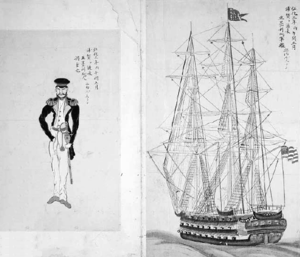USS Columbus (1819)

USS Columbus
|
|
| History | |
|---|---|
| Name: | USS Columbus |
| Builder: | Washington Navy Yard |
| Launched: | 1 March 1819 |
| Commissioned: | 7 September 1819 |
| Decommissioned: | March 1848 |
| Fate: | Scuttled, 20 April 1861 |
| General characteristics | |
| Tonnage: | 2480 |
| Length: | 191 ft 9 in (58.45 m) |
| Beam: | 53 ft 5 in (16.28 m) |
| Draft: | 25 ft (7.6 m) |
| Complement: | 780 officers and men |
| Armament: | 68 × 32-pounder (15 kg) guns, 24 × 42-pounder (19 kg) carronades |
USS Columbus was a 74-gun ship of the line in the United States Navy. She was launched on 1 March 1819 by Washington Navy Yard and commissioned on 7 September 1819, Master Commandant J. H. Elton in command.
Clearing Norfolk, Virginia on 28 April 1820, Columbus served as flagship for Commodore William Bainbridge in the Mediterranean until returning to Boston on 23 July 1821. Serving as a receiving ship after 1833, she remained at Boston in ordinary until sailing to the Mediterranean on 29 August 1842, as flagship for Commodore Charles W. Morgan. On 24 February 1843, she sailed from Genoa, Italy, and reached Rio de Janeiro, Brazil, on 29 July to become flagship of the Brazil Squadron, Commodore Daniel Turner. She returned to New York City on 27 May 1844 for repairs.
After embarking Commodore James Biddle, Commander, East India Squadron, she sailed on 4 June 1845 for Canton, China, where on 31 December Commodore Biddle exchanged ratified copies of the first American commercial treaty with China. Columbus remained there until April 1846, when she sailed for Japan to attempt opening that country to American commerce. She raised Uraga Channel on 19 July in company with Vincennes, but achieved no success. Recalled at the outbreak of the Mexican-American War Columbus reached Valparaíso, Chile, in December and arrived off Monterey, California, 2 March 1847. Too large to be useful in the California operations, the ship sailed from San Francisco on 25 July for Norfolk, arriving on 3 March 1848.
...
Wikipedia
